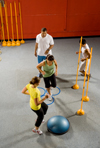Archive for February 2010
Successful Yoga-Pilates Fusion
When Pilates and yoga first hit mainstream fitness over a decade ago, instructors enthusiastically fused these traditional methods with everything from kickboxing to weight lifting, disco and rollerblading. While many of these fads have fizzled, the fusion of Pilates and yoga remains a popular combination—and one that has continued to mature since the hundred was first introduced to downward-facing dog.
Read MoreSample Class: 30-Minute Cardio-Strength
Format: This is a stationary circuit/a>, which means all exercises are executed simultaneously—as a group—with the instructor leading (no stations). Following a 3- to 5-minute warm-up, the main workout comprises three blocks of time-based cardio segments and repetition-based strength exercises for both upper and lower body.
Read More3 Keys to Signing New Clients
You want to close every client who walks through your door. But initial consultations can be uncomfortable for trainers and clients alike. Both parties may feel self-conscious and insecure. Many clients are anxious about their physical issues and/or appearance, and trainers may have less confidence in their business skills than their training skills. Below are three strategies that can help you communicate effectively and close the deal in those crucial initial consultations.
#1: Interacting With People
Read MoreKettlebells: 5 Full-Body Exercises
Kettlebells, while not new, are quickly becoming the go-to training method for elevating functional workouts for a wide variety of clients. As long as both trainer and participant receive proper instruction, kettlebells can provide a safe, effective, time-efficient workout that engages multiple muscle groups, including the core. No muscle can escape a “swing” workout, so pick up a kettlebell when you have a chance!
Kettlebell Safety
Read MoreSmall-Group Training Techniques
Over the last several years, small-group personal training has dramatically increased in popularity. This form of training is not only time-effective for the personal trainer but economical for many clients who are unable to afford private sessions. However, many trainers who excel in a one-on-one training environment struggle when attempting to coordinate group sessions.
Read MoreWhat Makes Bone Adapt: Gravitational Forces or Muscle Loading?
Exercise professionals regularly exclaim the benefits of exercise for maintaining and improving bone mineral density and bone health. They describe the benefits of gravitational weight-bearing exercise (i.e., ground-impact activities, such as walking, running and jumping) and muscle-loading activities, such as weight training. However, scientists are currently debating which exercise intervention provides more beneficial bone health adaptations.
Read MoreCell Phone Apps Feature Yoga, Pilates, Tai Chi and Meditation
Using your iPhone as a tool for practicing yoga, Pilates, tai chi or meditation is only a click away. The iTunes Store features
hundreds of apps
(ranging in price
from free to $19.99)
to support anyone’s
favorite mindful
discipline. The store
also offers topical
books, yoga TV
series and even
yoga movies.
Muscle Strength Associated With Lower Risk of Alzheimer’s
More muscle strength is associated with a reduced risk of Alzheimer’s disease and cognitive decline, according to a study published in the Archives of Neurology (2009; 66 [11], 1139–44). Researchers from Rush University Medical Center in Chicago, Illinois, studied more than 900 residents of retirement communities in the Chicago area who had no dementia at the beginning of the study. The scientists measured strength in nine muscle groups and then compared results with strength measurements and cognitive function approximately 31/2 years later.
Read MoreTop Stressors for Children
Children experience stress even if they don’t have all
the responsibilities of adults. Adverse experiences in childhood can impact both short- and long-term health. According to the Nemours Foundation, sources of
childhood stress include
Brief Mindfulness Meditation Training Reduces Pain
A 3-day mindfulness meditation program reduced pain ratings and anxiety scores for young adults with no prior meditation training, according to a small study published in The Journal of Pain (2009; doi: 10.1016/j.pain.2009.07.015). What is important about this study is that researchers showed improvements in mindfulness and pain reduction after only three consecutive 20-minute training sessions.
Read MoreAthletes and Protein
As an athlete, you want to make sure you fuel your body in a way that supports performance in your sport—and life. How much and what kind of protein is best?
Natalie Digate Muth, MD, MPH, RD, a graduate of the University of North Carolina School of Medicine, a registered dietitian and an American Council on Exercise master trainer, offers practical tips on how to choose protein sources.
The Latest Findings on Vitamins & Minerals
Rarely does a day go by without some new nutrition study making the news. The science of nutrients—especially specific vitamins and minerals—is dynamic, and new findings surface regularly. There can be a lot of information to keep straight, and we don’t get much help from the media, whose priority is the news hook. “The result can be incomplete information and, sometimes, inaccurate recommendations,” says Carol S.
Read MoreDaily Skills Training for a Parkinson’s Patient
Client: Penny
Exercise Physiologist: Marla Richmond, MS
Location: Deerfield, Illinois
Fun and Function for Youth
Another grim doctor’s appointment: Tim’s excessive body weight, high blood pressure and high cholesterol are a growing concern for his doctor. Tim has become a walking risk factor for heart attack, stroke and type 2 diabetes. In addition, his weight has created pain in his joints and other body structures, making it hard for him to move or exercise. He used to play sports, but as his body weight rose, movement became more difficult and painful, causing him to stop physical activity all together. Tim is in the 6th grade.
Read More“The Magazine Alone Is Worth the Membership Fee”
For years I have encouraged fellow
personal trainers and group fitness instructors to join IDEA, telling them the magazine alone is worth the membership fee. Your January issue has more than proved my words true. It was simply outstanding. I especially enjoyed the articles by Stuart McGill, PhD (“The Painful Lumbar Spine”), and Ellen Langer, PhD (“If You Don’t Mind, It Really Does Matter”), but the entire issue gave me a great deal to think about. Thank you so much for the continued excellence.
Janet Weller, RN, CES
Beyond Energy Imbalance
Today, two out of three American adults are overweight or obese, and another 5.9% are now considered extremely obese (body mass index ≥ 40) (CDC). Excess weight increases the risk for heart disease, stroke, diabetes, several cancers, gallbladder disease and more. To fight the extra weight, Americans spend billions of dollars a year on diets and products promising weight loss, only to fail along the way. Considering these facts, it’s not surprising that clients approach you with questions about how to shed pounds fast.
Read MorePre-Race Chicken and Veggie Pasta
It’s the day before the big race, and it’s time to carbo-load. This simple pasta dish is quick
to prepare and easy to digest, two features that can loom large on the eve of your event.
8 ounces uncooked penne pasta
2 tablespoons plus 2 teaspoons
extra-light olive oil (divided use)
11/2 pounds boneless, skinless chicken
breasts, sliced into thin cutlets
1 medium onion, chopped
2 large carrots, thinly sliced
1/4 pound asparagus, thinly sliced
skinny cookbooks
Nutrition experts often point to today’s supersized plates and glasses as one cause of America’s rising obesity rates. Now
researchers are pointing to another culprit: corpulent cookbooks.
top 10 most-Hated foods
George H.W. Bush wasn’t the only one who hated broccoli. According to the findings of a 2007 survey reported in The Journal of Psychology, broccoli ranks high in foods disliked by the masses.
Read MoreIs there really a difference between brown and white eggs?
There is a difference, but it’s not in nutritional quality—it’s in the breed of hen that laid the egg. It’s
really quite simple: most breeds with white feathers lay white eggs, whereas brown eggs tend to come from breeds with brown
or red feathers. Both types of eggs have the same nutrient content and taste. The nutrient content is determined by the type and quality of feed fed to the hens.




